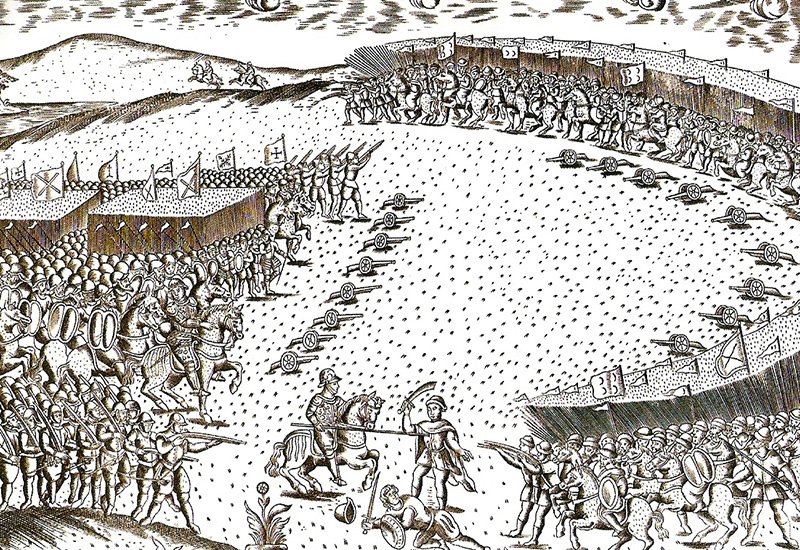In 1573, the small provincial village of Lagos experienced a momentous event – it was elevated to city status. Now 450 years later, the municipality is evoking the historical milestone with celebrations and festivities throughout the year. There is a special focus on the legendary figure of Dom Sebastian.
So why was Lagos bestowed with this unique honour? Dom Sebastian, the king at the time, visited Lagos with his royal entourage for the first time in January 1573. He inspected the fort at Sagres and other fortifications along the coast and participated in a mass at the Chapel of Nossa Senhora da Piedade. His birthday on 20 January was celebrated with great fanfare. The village must have impressed him so much that, on 27 January of the same year, he proclaimed it a city, the only one in his reign that received this honour. He also established the residence of the Governor of the Kingdom of the Algarve, making the city the most important one in the region.
In Praça Gil Eanes, one of the main squares of Lagos, there is a statue by João Cutileiro (1973) of the young king dressed in oversized armour, perhaps symbolising his subsequent reckless mission in the north of Morocco.
Who was Dom Sebastian, The Boy King, who contributed significantly to the evolution of Lagos but whose actions had fateful consequences for the country?
On 20 January 1554, Sebastian was born heir apparent to the throne of Portugal as his birth occurred two weeks after his father’s death. The situation had left the kingdom in shock as his father was the only surviving child of nine. The kingdom’s succession came to depend on the success of his birth. Hence, Sebastian gained the epitaph ‘The Desired’. The baby never saw his mother, Joanna of Austria again. She left for Spain to serve as regent for her father.
At the age of three, Sebastian ascended to the throne with a regency established by his grandmother Catarina, Queen of Austria, and later by his great-uncle, Cardinal D. Henrique de Évora, until he came of age. Catarina, who looked after him, was a domineering woman and had him under strict control. His primary influence, however, was the austere education received by the Jesuits. He became highly devout, seeing himself as Christ’s captain, destined to defend Christendom.
After attaining his majority in 1568, aged 14, his overriding ambition was to organise a crusade against the kingdom of Morocco. What prompted him to undertake such a venture? Perhaps illusions of grandeur and religious fervour, albeit combined with little military experience, drove him to save the Christian world. The young king had been concerned about the Ottoman Turkish Empire’s occupation of North Africa, which still excluded Morocco. He promised support for the deposed sultan of Morocco against his uncle, who had Ottoman support.
In 1578, he came to Lagos and bid farewell to the people of the city. He stood at the Manueline window (the square one on the right with an opaque coating) in the Governors’ Palace overlooking the Jardim de Constituição while Mass was said. It was to be his last visit to the city that must have been close to his heart.

He sailed to Morocco to begin the crusade along with his army of 17,000 men, which included nearly all the country’s nobility and many foreign mercenaries. The expedition culminated in the battle of Alcácer-Quibir, also known as the Battle of the Three Kings, as none of the three rulers, the deposed sultan, his rival and Sebastian, survived. Sebastian’s last words on the battlefield before leading the desperate attack against the superior enemy are said to have been: “Gentlemen, real freedom can only be lost with your life.” He then charged his horse against the enemy line, never to be seen again.
The death of the heirless king at the battlefield, along with 9,000 men and the cream of the nobility, had severe consequences, endangering Portugal’s independence. Rescuing the survivors also drained the country’s financial resources. A dynastic crisis ensued, with the Spanish Felipe II coming out on top. He managed to ascend the Portuguese throne and unite the governments of the Iberian Peninsula. For the next 60 years, Portugal lost its independence, including its entire empire. The crusade had been a resounding defeat.

As the body of Dom Sebastian was never found, it started the legend that ‘The Dormant’ or ‘The Disappeared’ would one foggy morning return to help Portugal in its darkest hour – an image similar to that of King Arthur in England. It was a myth that perhaps was needed to maintain Portugal’s identity. The dream grew and became a movement called Sebastianism. Over the centuries, it gave rise to many songs, poems, theatre pieces and even operas.
One can safely say that Dom Sebastian was one of the most extraordinary monarchs in Portugal’s history. There was great expectancy when he ascended the throne, widely acclaimed as the answer to his subjects’ prayers and the one who would save his country’s independence. Two decades later, he achieved exactly the opposite. He died unnecessarily on the North African battlefield leaving no heir to succeed him.

However, he did achieve positive things during his short rule. He seemed to have had a social conscience and did much to assist people experiencing poverty. During the great plague of Lisbon in 1569, he enlisted doctors from Seville to help Portuguese doctors fight the plague. He built two hospitals in Lisbon to accommodate those afflicted with the disease. For widows and orphans, he created shelters, Recolhimento de Santa Maria. There were scholarships for students wishing to study medicine or pharmacy at the University of Coimbra. Communal granaries were established to help farmers cope during bad harvests. In 1570, he ordered that Brazilian Indians should not be enslaved and demanded the release of anyone in captivity. The administrative, judicial and military life in his kingdom was also re-structured. He was only 24 years old when he died. How much more could he have achieved in his lifetime, one wonders?
Dom Sebastian may have been a controversial figure, but he changed the course of history for better or worse. For Lagos, the impact was significant. So, let’s join in with the commemorations.

The celebrations in Lagos began on 27 January with conferences, concerts, exhibitions, and guided tours. Much more will follow.
Don’t miss the Festival of Discoveries from the 4 to the 7 May. It promises to be a colourful affair with plenty of historical enactments during the four-day extravaganza.
For keen photographers, there is still a chance to participate in the Lagos Cidade photo competition. Think creatively about what Lagos means to you. Whatever seems permanent or transitory about the city, its history and culture, lights and colours, are some themes that could be captured. The deadline for entries is 15 June. A selection of photographs will be on show at the Feira Concurso Arte Doce, Sweet Festival (26 to 30 July). Three winning entries will receive prizes.













